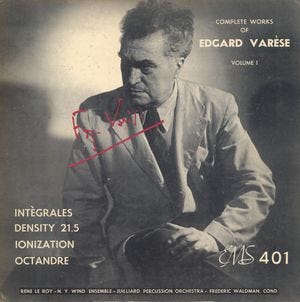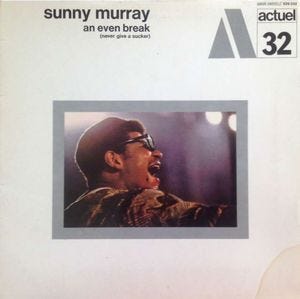Some Jazz Records: Sunny Murray Clippings
Comments on recordings from musicians and other actors of the jazz scene. Random and not-so-random listening cues from the archives.
Edgard Varèse, Complete Works, Volume 1, the New York Wind Ensemble and Juilliard Percussion Orchestra conducted by Frederic Waldman, EMS 401, 1951, LP.
"I remember Cecil [Taylor] and Jimmy [Lyons] and Bill Dixon and me did some duplex thing with Edgard Varèse, because he used to live there on Waverly and MacDougal St.," Sunny Murray told Clifford Allen during a 2003 interview. "I remember I was really young and just beginning to understand where I was going, and we did that with Mr. Varèse, he had a duplex apartment, and we all got on different levels, him and Cecil were down below, and I remember that experience, but it opened my mind up to the possibilities, and of course after that I went and bought the record Ionisation." Placing this encounter with Varèse precisely is not easy. Scholarship on the composer has documented a series of sessions pairing him with jazz musicians between March and August 1957, but the names given by Murray suggest a slightly later date. If, as is probable, the encounter did not postdate the late 1950s, the release obtained by Murray was presumably a 1951 LP that remained the principal documentation of Varèse’s work on record through the decade.
Miles Davis, Miles Davis in Europe: Recorded Live at the Antibes Jazz Festival, Columbia CL 2183 (CS 8983), 1964, LP.
Sunny Murray’s shimmering cymbal sound was one of the defining aspects of his playing. He discussed its inception with Graham Lock in his book Chasing the Vibration: Meetings with Creative Musicians. "I had really defined a very good open rhythm—I was trying to get away from the bass drum, as it was," the drummer said. "I was trying to get into the rapidity of beats to produce the sensation of tones—like, if you take a piano and hit the same two notes in succession, you’ll get a third tone, and this is what I was trying to do with beats. Then, when I started playing with Albert [Ayler], I started to go for the cymbal groove. I’d had a bebop cymbal thing at first, but I knew with Albert I needed a different cymbal groove. So I’d been playing this new cymbal groove for about a year when we came to Europe—Albert, Don Cherry, Gary Peacock—and I heard a record Tony Williams had made with Miles, and Tony was trying to get into a cymbal groove—and it was my cymbal groove! I said to Albert, I’m gonna play the cymbals so fuckin' loud till there ain’t no sound left! So there was no more sound left in the cymbals for nobody to find for six years—and by that time Tony had gone in another direction [laughs]." The Ayler group started its European tour in September 1964. By this time, only two Miles Davis albums featuring Tony Williams had been released, Seven Steps to Heaven and, very recently, Miles Davis in Europe. Williams played only on half of the former, but on the latter’s faster numbers, he can be heard bringing his cymbals to a shimmering blur and this is probably the record mentioned by Murray. (See also Ornette Coleman and Sonny Sharrock's comments on this record.)
Sunny Murray, An Even Break (Never Give a Sucker), BYG 529.332, 1970, LP.
During an interview with Cadence at the end of the 1970s, roughly twenty years after he started his avant-garde journey, Sunny Murray was asked what group he played with he would consider the strongest. "The band I enjoyed most was for a minute in '69 and '70," Murray answered. "Malachi Favors, Kenny Terroade, Byard [Lancaster] and Dave Burrell, I like that band very much. Made one recording." The album made by that band, which was assembled in Paris after Amougies’s Festival Actuel, was taped for BYG in the French capital in November 1969. Dave Burrell, then in Hawaii, could not take part in the session.






